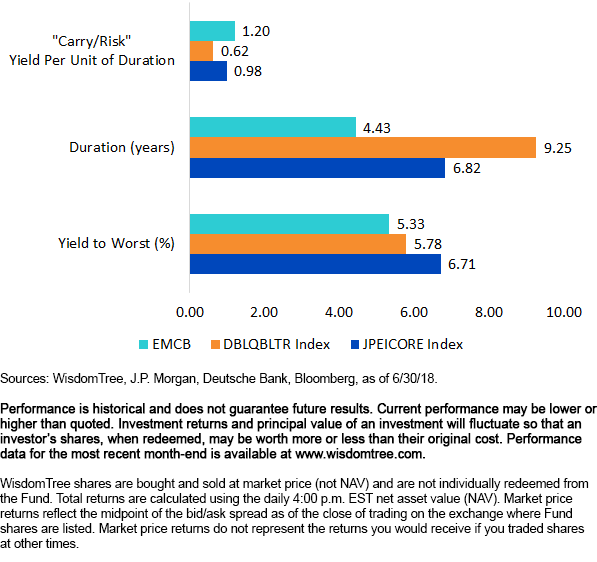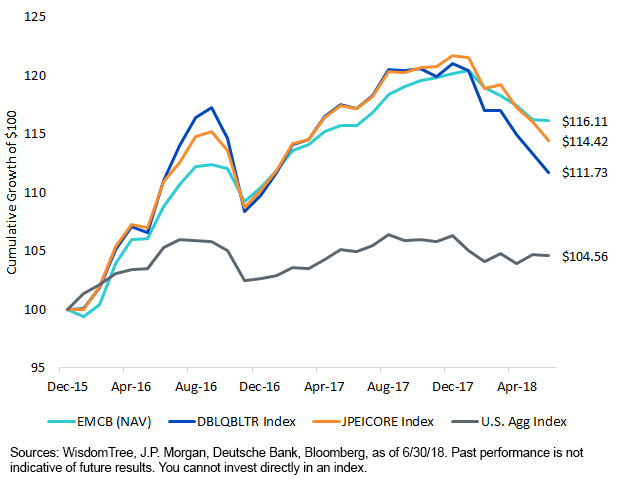Amid EM Sell-off, How Corporates Can Add Value to Core Portfolios


As geopolitics continues to shake investor confidence, U.S. interest rates have fluctuated and emerging market assets have come under pressure. In our view, this move could present unique opportunities for investors to decrease interest rate risk while at the same time enhancing the income profile of their core bond portfolio. Emerging market (EM) bonds could serve as an attractive diversifier, offering typically higher levels of yield, comparable credit quality and the ability to partake in the overarching global macro growth story. Given all the optionality within the EM bond universe, we believe that EM corporate bonds, issued in U.S. dollars (USD), can offer an intuitive alternative to EM sovereign bonds.
Why EM?
Despite recent underperformance, EM bonds have added significant value to global portfolios since reaching their bottom in 2015. One catalyst for this rebound has been the recovery in oil prices. Crude oil futures have risen from their near-$25 lows in 2015 to $74 through the end of June. We also have seen an acceleration in broad EM gross domestic product (GDP) growth, attractive valuations compared with the U.S. markets and continued easing from many EM central banks. All these catalysts, together with a growing consumer class, robust earnings growth and improving economic data, should continue to be indicators of strength for those seeking opportunities within their globally diversified portfolios.
Within EM fixed income, investors can allocate via local currency debt or hard currency (that is, USD). Investing in USD-denominated bonds, as opposed to locally denominated bonds, typically allows investors to dramatically reduce volatility and eliminate one of the main risks of EM investments and causes of recent EM underperformance: the value of foreign currencies against the U.S. dollar. Within dollar-denominated fixed income, investors also have the option to allocate in sovereign debt or corporates.
Corporates vs. Sovereigns: Better Quality, Lower Duration, Attractive Yield
The WisdomTree Emerging Markets Corporate Bond Fund (EMCB) is an actively managed fund that seeks to provide a high level of total return from both income and capital appreciation through investments in corporate EM debt, issued in USD. If you take this fund and compare its credit quality, yield and duration profile to two of the largest EM, USD-denominated, sovereign debt indexes, the DBIQ Emerging Markets Liquid Balanced Index (DBLQBLTR) and the J.P. Morgan EMBI Global Core Index (JPEICORE)— [which combined are tracked by billions of dollars of ETF assets]—the trade-off is staggering. EMCB is approximately 67% investment grade, with less than 1% of its remaining 32% high-yield exposure coming from debt that’s rated CCC or below. However, DBLQBLTR and JPEICORE are approximately 46% and 59% investment grade, respectively, with a much larger high-yield allocation tilting toward the “junkier” end of the credit spectrum.
Currently, an investor in EMCB can expect a yield of over 5% at a nearly 35% to 52% reduction in overall duration/interest rate risk. For a cost of only 45 to 138 basis points of yield (a mere 8% to 21% reduction), one can meaningfully improve their “carry-to-risk,” the amount of yield per unit of duration (risk), as illustrated below.
Figure 1: Yield & Duration of Corporates vs. Sovereigns

For standardized performance of EMCB, please click here.
For definitions of terms in the chart, please visit our glossary.
Don’t Let Rising Rates Get You Down
EM bonds have really held their own in the current U.S. rising interest rate environment. Since the Federal Reserve (Fed) began to raise interest rates in the U.S. in December 2015, we have seen EM bonds significantly outpace the Bloomberg Barclays U.S. Aggregate Index (the Agg), and, given the generally less rate-sensitive nature of corporate bonds, this could continue to be a strong time of outperformance.
Figure 2: Cumulative Performance Since U.S. Rate Hikes Began (12/31/15–6/30/18)

During this “rising rate” period, EMCB experienced significantly lower levels of volatility and higher levels of Sharpe ratio (see figure 3 below). Year-to-date we have seen nearly all EM bonds lag, and yet, when compared with its sovereign counterparts, EMCB has provided less downside capture and, thus, alpha.
Figure 3: Performance, Volatility and Sharpe Ratio (12/31/15–6/30/18)

Conclusion
For those seeking ways to increase portfolio yield without inheriting excessive levels of risk, we continue to believe strongly in EM corporate debt. During the current rising interest rate environment, EM corporate bonds have offered strong returns in an otherwise performance-stricken period. With comparable levels of yield, lower duration and higher credit quality than U.S. high-yield or EM sovereign debt, investors should think about how EM corporate bonds can play an integral role in their overall fixed income portfolios.
All data as of June 30, 2018. Sources: WisdomTree, Bloomberg, Zephyr StyleADVISOR.
Important Risks Related to this Article
There are risks associated with investing, including possible loss of principal. Foreign investing involves special risks, such as risk of loss from currency fluctuation or political or economic uncertainty. Investments in emerging, offshore or frontier markets are generally less liquid and less efficient than investments in developed markets and are subject to additional risks, such as risks of adverse governmental regulation and intervention or political developments. Derivative investments can be volatile, and these investments may be less liquid than other securities and more sensitive to the effects of varied economic conditions.
Fixed income investments are subject to interest rate risk; their value will normally decline as interest rates rise. In addition, when interest rates fall, income may decline. Fixed income investments are also subject to credit risk, the risk that the issuer of a bond will fail to pay interest and principal in a timely manner or that negative perceptions of the issuer’s ability to make such payments will cause the price of that bond to decline. Unlike typical exchange-traded funds, there is no index that the Fund attempts to track or replicate. Thus, the ability of the Fund to achieve its objective will depend on the effectiveness of the portfolio manager. Please read the Fund’s prospectus for specific details regarding the Fund’s risk profile.


